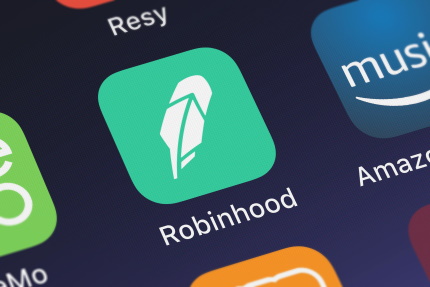Formed in 2013, Robinhood Markets (HOOD) became a publicly traded company in late July with much fanfare. The company is widely considered the leader in pioneering commission-free trading for stocks and exchanged-traded funds through its popular mobile trading platform.

Shares made their debut on July 29th at $38 a share but were priced at the low end of its initial public offering range. After sinking as much as 10% and ending the session just south of $35, Robinhood’s market capitalization was valued at $29 billion.
The company has enjoyed rapid growth and has quickly risen to the third-largest brokerage firm based on number of funded accounts. Fidelity and Charles Schwab, which acquired TD Ameritrade in 2020, are ranked one and two.
Some of the IPO hype was justified, as Robinhood was profitable last year, generating income of $7.45 million on revenue of $959 million—up from a loss of $107 million on revenue of $278 million in 2019.
Much of the dramatic growth in 2020 came from new investors entering the stock market during the coronavirus pandemic. It continues this year, thanks in part to the frenzied trading in the so-called meme stocks that are profiled on Reddit and other online forums.
While this has been good news, it was also a burden: the company reported a loss of $1.4 billion in the first quarter of this year, following fundraising-related losses and the euphoria that involved shares of GameStop (GME). Numbers were announced in August for HOOD’s most recent quarter, with the company reporting a loss of $2.16 per share on revenue of $565 million.
Monthly active Robinhood users increased 109% to 21.3 million, compared with 10.2 million in the second quarter of 2020. Assets on its platform increased over 200% to $102 billion, compared with $33 billion in the year ago period.
For the current quarter, Wall Street expects an average loss of $1.32 a share on revenue of $424 million. Some analysts have forecasted a loss as high as $1.77, with the lowest predictions at $0.96 per share.
HOOD shares jumped nearly 11% last week after the company announced crypto wallets will be available on the Robinhood platform, starting next month. The company also said it will continue to roll out access to more and more customers through a waitlist that will allow investors to move, send, and receive crypto into their account.
While this was welcomed news for crypto traders, competition is fierce with the likes of Coinbase Global (COIN), PayPal (PYPL) and Square (SQ) also in the space. Additionally, meaningful revenues won’t come until future quarters.
As far as the technical setup, shares are down from a high of $85 and recently appeared to bottom at the $40 level. The gap above the $42.50 level came on the crypto update, with near-term resistance at $47.50.
Conservative traders betting on continued growth and a return to profitability in 2022 (or 2023) could initiate half or third positions at current levels with the opportunity to add to their position if the $40 level fails to hold. The low of $33.25 came a day after HOOD’s IPO debut and would be an ideal price to round out the position.
Aggressive traders that like options can target the near-term HOOD January 50 calls that are currently trading for $4. These options are out-of-the-money, with shares needing to clear $54 by mid-January, technically, for the trade to breakeven.
If shares catch fire on an earnings beat and rally into January towards $58, the options would double from current levels as they would be $8 in the money. A stop limit can used to protect the remaining premium if shares do happen to fall back below $40.
[insert CTA: 30DDU – Double Your Money Every Month]





